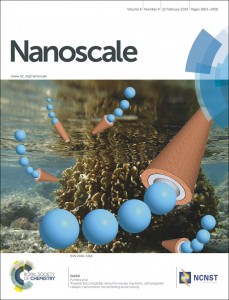This month sees the following articles in Nanoscale that are in the top 10 most accessed from October – December:
Synthesis of Li–Mn–O mesocrystals with controlled crystal phases through topotactic transformation of MnCO3
Feng Dang, Tatsuhiko Hoshino, Yuya Oaki, Eiji Hosono, Haoshen Zhou and Hiroaki Imai
Nanoscale, 2013,5, 2352-2357
DOI: 10.1039/C3NR33767G, Paper
Supramolecular self-assemblies as functional nanomaterials
Eric Busseron, Yves Ruff, Emilie Moulin and Nicolas Giuseppone
Nanoscale, 2013,5, 7098-7140
DOI: 10.1039/C3NR02176A, Review Article
6.5% efficient perovskite quantum-dot-sensitized solar cell
Jeong-Hyeok Im, Chang-Ryul Lee, Jin-Wook Lee, Sang-Won Park and Nam-Gyu Park
Nanoscale, 2011,3, 4088-4093
DOI: 10.1039/C1NR10867K, Communication
Nanostructured carbon–metal oxide composite electrodes for supercapacitors: a review
Mingjia Zhi, Chengcheng Xiang, Jiangtian Li, Ming Li and Nianqiang Wu
Nanoscale, 2013,5, 72-88
DOI: 10.1039/C2NR32040A, Feature Article
Double shelled hollow nanospheres with dual noble metal nanoparticle encapsulation for enhanced catalytic application
Baocang Liu, Qin Wang, Shengli Yu, Tuo Zhao, Jiaxing Han, Peng Jing, Wenting Hu, Lixia Liu, Jun Zhang, Ling-Dong Sun and Chun-Hua Yan
Nanoscale, 2013,5, 9747-9757
DOI: 10.1039/C3NR02759G, Paper
Graphene-related nanomaterials: tuning properties by functionalization
Qing Tang, Zhen Zhou and Zhongfang Chen
Nanoscale, 2013,5, 4541-4583
DOI: 10.1039/C3NR33218G, Review Article
Focusing on luminescent graphene quantum dots: current status and future perspectives
Lingling Li, Gehui Wu, Guohai Yang, Juan Peng, Jianwei Zhao and Jun-Jie Zhu
Nanoscale, 2013,5, 4015-4039
DOI: 10.1039/C3NR33849E, Review Article
Phase transitions and thermodynamic properties of dense assemblies of truncated nanocubes and cuboctahedra
Nikolai Volkov, Alexander Lyubartsev and Lennart Bergström
Nanoscale, 2012,4, 4765-4771
DOI: 10.1039/C2NR30411B, Paper
Recent advances in the efficient reduction of graphene oxide and its application as energy storage electrode materials
Tapas Kuila, Ananta Kumar Mishra, Partha Khanra, Nam Hoon Kim and Joong Hee Lee
Nanoscale, 2013,5, 52-71
DOI: 10.1039/C2NR32703A, Review Article
Graphene synthesis: relationship to applications
Rebecca S. Edwards and Karl S. Coleman
Nanoscale, 2013,5, 38-51
DOI: 10.1039/C2NR32629A, Review Article
Why not take a look at the articles today and blog your thoughts and comments below.
Fancy submitting an article to Nanoscale? Then why not submit to us today!














 Nanoscale is delighted to present its
Nanoscale is delighted to present its 


 Nanoscale is delighted to present its
Nanoscale is delighted to present its 
 Nanoscale is delighted to present its
Nanoscale is delighted to present its 